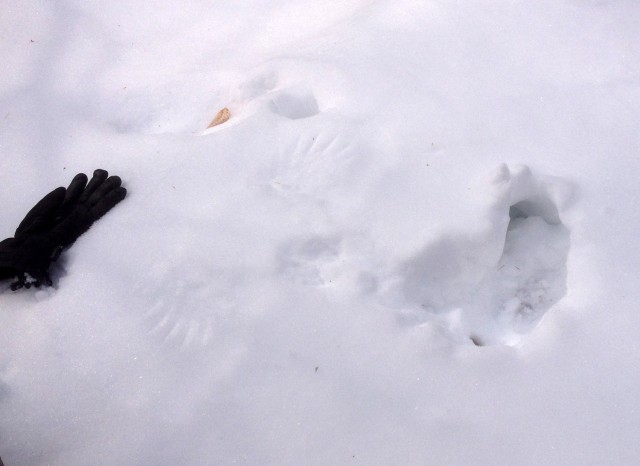
I don’t recall whether or not I was fascinated with animal and bird tracks in snow as a child, but I suspect I was. I am now… (Fox Tracks, Foxtrot & X-Country Skiing)
It wasn’t until my nephews (now teenagers but still “pocket sized” then) began asking me to identify bird tracks in snow, four legged critter tracks on muddy paths, and snake trails on the sand that I rediscovered how exciting it is to decipher locomotive narratives on the ground. That was more than a decade ago. The boys’ interests have wandered from bird tracks in snow to life’s adventures, but I’m still wandering around looking at the ground trying to figure out what passed where. And when. And why.
I’ve collected a backlog of track photos, mostly shot on a mobile phone because it’s often all I have along. I’m not sure I’ll manage to ever aggregate all of the photos in any comprehensive and useful manner, but I will pass along some of them as fancy strikes.
Most of my recent photos of bird tracks in snow have been shot in Rosslyn’s back meadows and woods during lunchtime cross country ski and snowshoe outings, but that image of the mallard tracks comes from the lawn right outside the “morning room” where I eat breakfast. Susan has become an avid bird feeder, and this winter an endless parade of mallards have joined the daily buffet. There’s something lighthearted, even happy about meandering duck prints!
Wing Prints in Snow
Less lighthearted but far more dramatic are the sort of wing prints visible in the photograph below which was captured by friend and Adirondack Coast neighbor, Kim Rielly.
Often a snow crater and feather printed like that will intercept the tracks of a squirrel or a rabbit. Sometimes a drip or two or scarlet in the snow to heighten the drama. But the story told by these bird tracks in the snow is more upbeat (and likely has a happier ending.)

Before we reached the actual trail, we stopped to see a great example of a “grouse hole”. The grouse entered the deep snow for shelter, and created the hole and accompanying wing marks in the snow when it emerged. Since the snow was so new, this must have been a recent rest stop for the bird. The hole itself had evidence of some feathers and “sawdust” looking stuff; positive clues. ~ Kim Rielly (Lake Champlain Region)
I learned to spot these grouse holes a few winters ago during a guided snowshoe trek, and I’ve been looking for the tell-tale “sawdust” (grouse scat) ever since. Not the coziest place to spend the night for those of us who depend on lasagna layered synthetic materials to stay warm and dry, but a downy grouse might well consider this the perfect winter’s repose!
I think it would be a great idea to collate all your findings into a book, for those of us who cannot get out quite as much as we want/like to.
What a fun idea. Thanks for your suggestion.